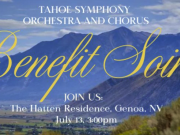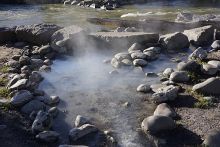
One of my favorite summer memories of Nevada is from a few years ago when we climbed into the car and made our way into the state’s interior. We explored the so-called ghost town of Unionville and then popped over to Kyle Hot Springs. This hot springs is Nevada to the core, with some old cattle watering tubs haphazardly strewn around the concrete, rock and mortar remains of a long-gone bathhouse, and historical as all get out. But as fun as that trek was, we’re lucky here in this corner of the Silver State in that we don’t have to travel halfway to Elko in order to enjoy some good ol’ geothermal soaking. Photo at left, Wikimedia Commons, Netherzone.
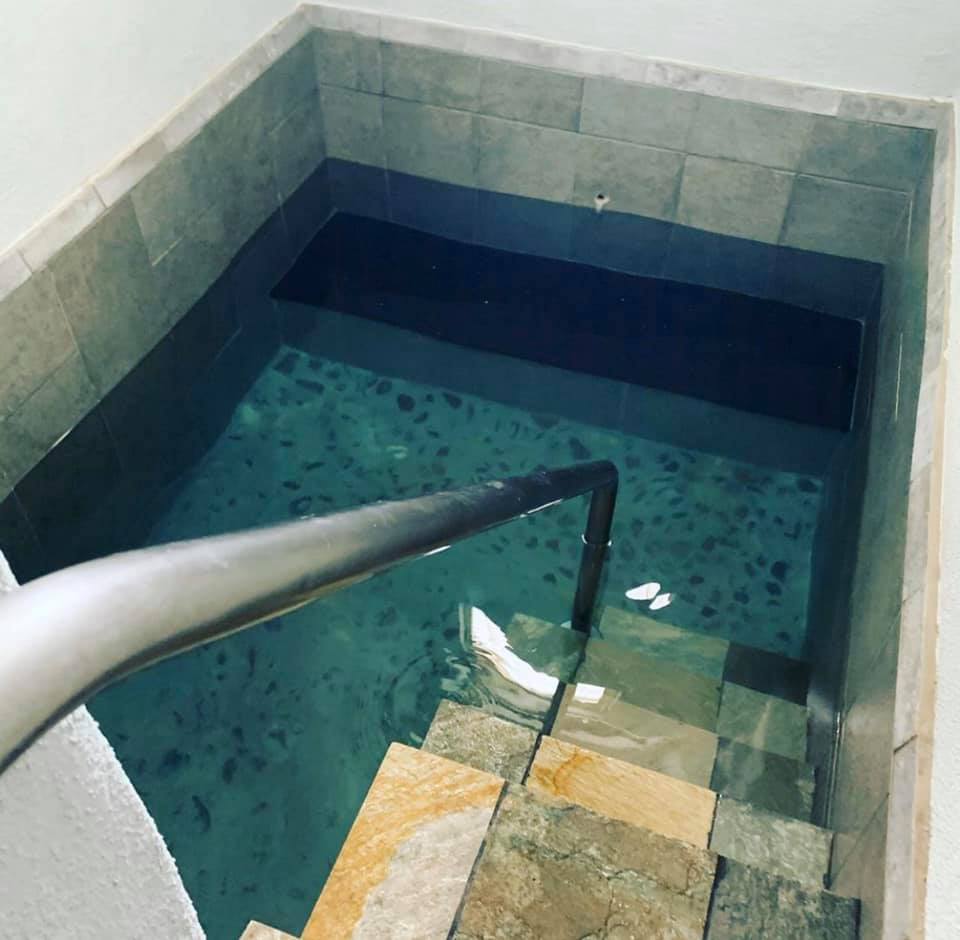 In fact, if you’re anywhere close to the north side of town, you are practically within spitting distance of the Carson Hot Springs, located – get this – on Old Hot Springs Road. Carson Hot Springs boasts its own fascinating history. Since 1849, the site has been known as Swift’s and Shaw’s and finally settled on its current name in 1910, the same year that the Big Blow Up, also known as the Great Burn, a forest fire that roared across the Pacific Northwest, killing 87 and consuming some three million acres of timber, an area roughly equivalent to the size of the state of Connecticut. But I digress. Carson Hot Springs has some new protocols in place in response to the recent COVID pandemic. For example, don’t come to the resort if you have a fever, wear a mask when you’re not in the water, there’s a cap of 50 people allowed at any given time and, in order to let as many people enjoy the site as possible, there’s a 2-hour time limit. And given how things change from day to day lately, you might want to give them a call and double-check before you just show up ready for a good soak. Photo at right: Facebook, Carson Hot Springs.
In fact, if you’re anywhere close to the north side of town, you are practically within spitting distance of the Carson Hot Springs, located – get this – on Old Hot Springs Road. Carson Hot Springs boasts its own fascinating history. Since 1849, the site has been known as Swift’s and Shaw’s and finally settled on its current name in 1910, the same year that the Big Blow Up, also known as the Great Burn, a forest fire that roared across the Pacific Northwest, killing 87 and consuming some three million acres of timber, an area roughly equivalent to the size of the state of Connecticut. But I digress. Carson Hot Springs has some new protocols in place in response to the recent COVID pandemic. For example, don’t come to the resort if you have a fever, wear a mask when you’re not in the water, there’s a cap of 50 people allowed at any given time and, in order to let as many people enjoy the site as possible, there’s a 2-hour time limit. And given how things change from day to day lately, you might want to give them a call and double-check before you just show up ready for a good soak. Photo at right: Facebook, Carson Hot Springs.
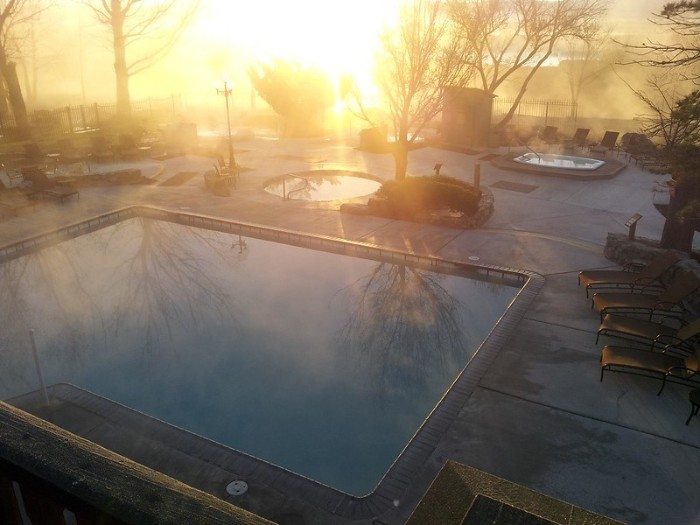 Built as a resort in 1862 and operated for some years as Genoa Hot Springs, Walley’s Hot Springs in the western foothills of the Carson Valley is another well-known and historically significant reminder of the area’s geothermal activity. The resort itself has gone through a number of ownership changes throughout the years, but the site will always be known locally as Walley’s, after the original owners. It has five mineral hot springs and a pool, steam room and sauna. If you’re not a guest at the resort, you can get a day pass to visit the hot springs, and they also have a locals’ discount for Tuesday and Wednesday. Walley’s is still on pandemic lockdown but plans to reopen later in the summer. Photo at left: flickr, Reno Tahoe Territory.
Built as a resort in 1862 and operated for some years as Genoa Hot Springs, Walley’s Hot Springs in the western foothills of the Carson Valley is another well-known and historically significant reminder of the area’s geothermal activity. The resort itself has gone through a number of ownership changes throughout the years, but the site will always be known locally as Walley’s, after the original owners. It has five mineral hot springs and a pool, steam room and sauna. If you’re not a guest at the resort, you can get a day pass to visit the hot springs, and they also have a locals’ discount for Tuesday and Wednesday. Walley’s is still on pandemic lockdown but plans to reopen later in the summer. Photo at left: flickr, Reno Tahoe Territory.
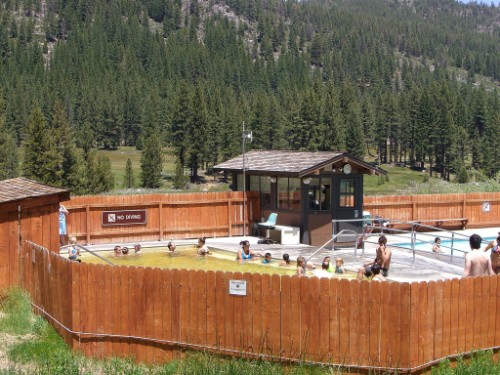 Heading even farther south, you can sneak over the state line and check out California’s Grover Hot Springs State Park. Named for one of the early owners of the springs in this high altitude ranching valley, it was acquired by the state in the 1950s and got its current formal title in 1959. The facilities here are open for business, but as with everything else, there are certain new rules and regulations in place to help ensure that the waters can be enjoyed safely. One of the most important things to realize is that use of the pool complex is by RESERVATION ONLY. You have to make the reservations at least two days in advance, and the reservation is for a specific 1.5-hour time slot, after which the area is cleared out, disinfected and then a new batch of reservation holders are allowed in. There are also no changing rooms available, so dress accordingly. Full info is available at the park’s website. Photo at right: Facebook, Friends of Grover State Park.
Heading even farther south, you can sneak over the state line and check out California’s Grover Hot Springs State Park. Named for one of the early owners of the springs in this high altitude ranching valley, it was acquired by the state in the 1950s and got its current formal title in 1959. The facilities here are open for business, but as with everything else, there are certain new rules and regulations in place to help ensure that the waters can be enjoyed safely. One of the most important things to realize is that use of the pool complex is by RESERVATION ONLY. You have to make the reservations at least two days in advance, and the reservation is for a specific 1.5-hour time slot, after which the area is cleared out, disinfected and then a new batch of reservation holders are allowed in. There are also no changing rooms available, so dress accordingly. Full info is available at the park’s website. Photo at right: Facebook, Friends of Grover State Park.
Of course, there are more hot springs peppered throughout the area. If you’ve got a hankering to travel north for a soak instead of south out of Carson City, click on over to my blog post in the Reno section of RenoThisWeek.com. You’ll have to sit through my same old story about Kyle Hot Springs at first, but then I’ll give you the skinny on some of the hot springs that are in the vicinity of the Biggest Little City.


 R. Keith Rugg has worked on staff for a number of local publications, including Lake Tahoe Action Magazine, the Tahoe Daily Tribune and the Reno Gazette-Journal.
R. Keith Rugg has worked on staff for a number of local publications, including Lake Tahoe Action Magazine, the Tahoe Daily Tribune and the Reno Gazette-Journal.
